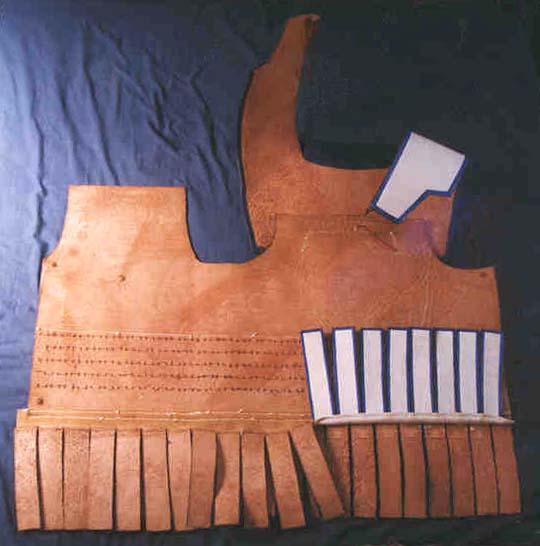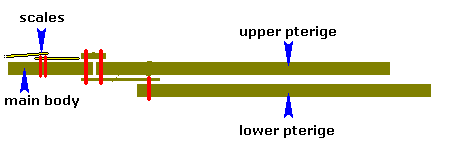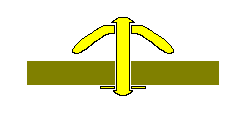 HOPLITE ARMOUR: Cuirass
HOPLITE ARMOUR: Cuirass
They were made out of linen, weren't they?
Er, well, possibly, but I think not. There is a long-standing idea that the ancient Greeks made their stiff body armour from linen, when they did not use bronze. The idea is that they got many layers of this cloth (usually about fifteen or so), and glued them together to make a stiff garment which would be of some use against blows. The actual evidence for this, though, is very far from convincing. The literary evidence is a single reference to "linen corsleted Argives" which can be interpreted a hundred ways, and certainly does not mean that all classical Greeks made armour from many layers of linen. It could be that the Argives were unusual in that they used linen. It could mean that the Argives had some garment which wasn't armour which was linen, or that they faced their armour with linen. The physical evidence is also very poor. There is a tiny scrap of some object, which would fit in a matchbox, consisting of many layers of linen. This was found in Mycenae, dating from a period nearly a millennium before classical Greek hoplites. That's not good enough for me.
Another snag with the linen-theory is that linen is very difficult, time-consuming and expensive to produce. You need to plant many acres of the plant, which is little use as food, and the processing takes many people and a lot of space. To make thousands of cuirasses this way, a small city-state would have to plan ahead a long way, and devote a lot of resources to the manufacture of linen, which was prized as a cloth for rich people to wear as everyday clothing.
It strikes me as far more likely that the Greeks used leather. They had cattle already, and used these for traction, meat, milk, and religious sacrifice, and so they would not have to devote any more land to leather production. Leather can be very thick, very tough, and very stiff. It would be so much cheaper and easier and quicker to make a cuirass from leather, that I think that I am justified in having made mine from this material.
I suppose that I should mention the only surviving cuirass of this type. It is from the so-called tomb of Philip II of Macedon (Alex's dad), at Vergina. The style and shape of this is the same as that pictured on vases and in temple sculptures, but the material is iron, with gold decoration. It seems fairly clear that this is a copy in metal of something which would normally be made in another material. I don't think that it sheds any light on this linen-or-leather debate (see Greece and Rome at War by Peter Connolly, p.58).
The leather I used was shoe-sole leather, about 3/8" thick (1 cm), which is tough stuff. When rude people come up to me while I'm wearing it, and knock on me as though I were a door, they hear a solid knock sound, as though I were a door. I usually reply by cheerfully punching them in the face. Even with the stoutest cutting tools, this stuff is tricky to cut, but it can be made much easier by soaking the leather in water first. Remember to mark the pattern on the leather while it is dry, because the leather will swell a bit when wet.
I started making the pattern by studying the one illustrated by Peter Connolly in his book. I corresponded with Peter, and he was helpful to a point, but I strayed in the end from his pattern in a number of ways. One major difference is that he has the top layer of pteriges (literally "feathers" - the strips at the bottom making a sort of skirt) as one with the main body of the cuirass, whereas I have the pteriges as separate. Since I was wanting to wear the cuirass myself, I had to make a pattern which would fit me. To this end, I drew one on thick two-ply corrugated cardboard, and tried it out. I made the whole pattern too big on purpose, and trimmed it down by stages until I was happy with the fit. To start with, there are just two pieces: the yoke which goes over the shoulders, and the body, which wraps around the torso. On my cardboard mock-up, I attached the two together with twists of plastic-wrapped wire, threaded through holes in the cardboard.

Here we see the cuirass laid out flat. Possibly, the ancient Greeks stored them this way. Possibly, when unworn, they were hung on walls.
On the left, you can see the two red-thonging ties, which tie at the left side of the torso of the wearer. I would have thought that a third central tie would have made the join a bit more secure, and on mine the join does tend to gape a little in the middle, but I have found no representation which shows a third tie on the side of a hoplite cuirass.
You can see the five rows of scales. These are one inch by two inches, with the bottom edges rounded off with tin-snips. Holes for sewing were drilled through the top square ends, with the help of a modern pillar drill and a simple jig. The top ends of the top row are hidden by a length of leather which overlaps them and is sewn along its top edge to the main body of the cuirass. I was planning eight rows of scales, and made enough scales for this, but I found that it was taking me seven minutes to attach one scale, and so I decided that five rows would be enough. There are examples of such narrow bands of scales pictured on ancient Greek pots.
On the bottom right of the photograph, you can see the end pterige of the lower row sticking out. The two rows of pteriges are staggered, so that the lower one covers the gaps of the upper. I tried making the pteriges longer on my original pattern, but then learned the hard way why they are so short on classical Greek examples. Any longer than this, and you can't sit down without the ends of the pteriges at the back's hitting the chair and bending uncomfortably. You will notice, as I have, that on all ancient sculptures and paintings which show long pteriges (later Roman, not classical Greek), which come down to protect the thighs, these are always shown as soft and flowing, rather than stiff, as classical Greek ones are. Presumably, with thinner, softer leather, this sitting problem is not encountered.
In the middle of the chest front (on the right, above), is the thing to which the two ties of the yoke are tied. Around it you can see some reddish smudges, where the red dye on the ties has made marks.
At the top of the picture is the yoke, which goes over the shoulders. If you look at ancient depictions of the pieces which come over the shoulder, they are not as wide as you might expect. If they are wide, they make you look terribly hunky and broad-shouldered. However, they also stop you from raising your arm. Try raising one arm now, directly upwards, go on, the whole arm straight upwards. Your biceps will be somewhere near your ear. Now, with the other hand, feel the width of the space where the shoulder piece would go, between your neck and your shoulder. You will notice, unless you are somewhat anatomically eccentric, that this space is very narrow indeed. Even with quite moderate shoulder "straps" (for want of a better term), you will not be able to raise your arm straight upwards while wearing a hoplite cuirass, bringing the upper arm to the horizontal is easy enough.
Between the shoulder straps, is a rectangular section which sticks up at the back of the neck. This protects the back of the neck from sun and blows, and has the extra benefit of holding the strap by which the sword and scabbard are suspended, away from the neck, stopping it from cutting in uncomfortably quite so much. I say "quite so much" because it still cuts in a bit, at the front.

The cuirass, inside view. Here we see the rough side of the leather, which is of course veg.-tan leather, as it should be.
Notice that the yoke is bending forward. I store my cuirass in the as-worn position, and over the years the yoke has taken on this shape.
You can see the line of linen thread stitching, which holds the yoke to the main body. To sew anything to leather which is this thick and tough, you will need a very sturdy awl. I made mine by grinding down a metal-working punch, and setting it in a handle. Make sure that you come up with some method for neatly spacing the holes you punch.
The single line of stitching, holding the upper of the two bands of leather which border the scales, is visible, as are the two rows holding the lower band. The bands of leather are about the thickness you would use for a good leather belt. I used "saddle stitch" and "saddlers' needles" and thick white linen thread. I threaded each end of a length of linen thread with a needle, then passed one needle through the leather and pulled until the length of linen was half on one side of the cuirass, and half on the other. I then sewed along the cuirass, from both sides, and the result is very strong stitching indeed.
The scales were sewn on with modern man-made fibre thread. Yes, this is a cheat, but I feared that the linen thread might break more often, and unlike an ancient Greek hoplite, I have no servants to repair my armour for me. As it has turned out, none of the stitching on the cuirass has ever failed, despite rough usage. Some scales have bent, but I have been able to bend them back into place without breaking any of the stitching. You can see the five rows of brown thread stitching, which hold on the scales.

The red lines show the lines of stitching, used to attach the pteriges. The lower band, at the bottom of the scales, has two lines of stitching going through it, securing the upper row of pteriges, and a wide band of softish leather on the inside of the cuirass, to which are sewn the lower pteriges. In the photograph of the inside of the cuirass, the wide softish strip of leather is bent on the right, to show us the inside of the lower pteriges.

This shows in section the brass fittings to which the red thonging ties are tied. A disc of metal is cut out, a hole is cut in its centre, and then the pierced disc is hammered into a dish shape. A small square of metal with a hole in it is cut out. A length of brass rod is cut, and one end of this hammered in a vice until it is mushroom-shaped. This rod is then threaded through the small square, through the leather of the cuirass, and through the dish, and the other end is hammered into a mushroom, to secure the lot. Some ancient examples of the dished part look quite fancy. Part of the trick is to get the distance between the rim of the dish and the outside of the cuirass, to be the same as the thickness of the thonging ties. That way, when you pull everything tight, the thonging holds the dish edges parallel with the outside of the cuirass. If you make the distance too small, the thonging will be difficult to tie under the dish, and if you get it too great, then the rod will be pulled out of the perpendicular.
The ties on the yoke are attached to brass D-rings, which are threaded through soft leather straps, which are sewn to the end of the shoulder straps.
That's near enough everything I have to tell you. I scored decorative lines around the edges of the leather parts, and painted between these lines and the edges blue, after painting the rest of the cuirass white. I used modern acrylic paints, which is another cheat. I was advised to do so by people who assured me that using the ancient hot-wax technique is very difficult. I do fear, however, that the people advising me thus (from the University's art department), were the sort who would never consider making real armour at all, and would be content with knitted string for mail. Perhaps it isn't that tricky at all. Certainly the ancients did not want for a variety of pigments. Do not use oil paints. Not only were these invented in the Renaissance period, but also they don't work very well on leather. I know, I tried.
So is it comfy, then?
I have worn the panoply for as much as three days on the trot, and have done a fair amount of vigorous exercise in it. I can report that I did not over-heat, and nothing has broken or fallen off. One does have to sit and stand pretty upright, but I see this as no bad thing. The only adverse affect I can report is nipple-rub. As I twist my torso, as I might as part of a running action, the stiff body of the cuirass does not twist with me, and the relative movement did chafe a bit after a while. Perhaps ancient Greek warriors had calloused nipples.
My cuirass weighs 14 pounds (about 6 kg) according to a spring balance I bought from a shop called Everything's a Pound. How typical this is of a cuirass of this sort, I could not tell you.
Happy armouring, everyone.
|
 HOPLITE ARMOUR: Cuirass
HOPLITE ARMOUR: Cuirass




 HOPLITE ARMOUR: Cuirass
HOPLITE ARMOUR: Cuirass



